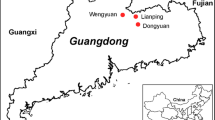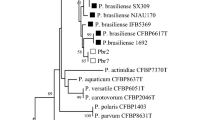Abstract
In recent years, melon culture in East China represented by Shanghai district has been severely affected by a stem rot disease. Symptoms were described as the presence of badly water-soaked soft rot associated with spilled brown juice in the later stages. Based on our disease diagnosis study, 30 bacteria were isolated from the stem tissues of affected plants and one bacterial pathogen, named EXXP-01, was highly virulent on melon stem dipped in bacterial suspension. This bacterium has caused significant damage in late autumn melon cultures, and a disease severity analysis presented as decay diameter of leaves and length of the stem rot suggested that the isolated pathogen not only caused extensive damage to the stem of melon, but also posed potential harm to the whole melon plant including seedlings and leaves. The strain EXXP-01 was also found to be most closely related to P. fluorescens based on physiological and morphological characterization, and also the sequencing analysis of 16S rDNA gene and 16S–23S rDNA internal transcribed spacer gene. Moreover, sequence analysis of another housekeeping gene, the RNA polymerase β-subunit gene (rpoB), indicated that P. fluorescens EXXP-01 could be classified as P. fluorescens bv. I. This confirmed that P. fluorescens is the causal agent of melon stem soft rot. Further bactericidal test in vitro suggested that the strain EXXP-01 has strong resistance to various germicides and should be worthy of attention.



Similar content being viewed by others

References
Aboaba O (2004) Growth studies of Pseudomonas fluorescens implicated in soft rot of purple variety of Onions in Southern Nigeria. Nat Sci 5:75–80
Anzai Y, Kim H, Park JY, Wakabayashi H, Oyaizu H (2000) Phylogenetic affiliation of the pseudomonads based on 16S rRNA sequence. Int J Syst Evol Microbiol 50:1563–1589
Bahar O, Kritzman G, Burdman S (2009) Bacterial fruit blotch of melon: screens for disease tolerance and role of seed transmission in pathogenicity. Eur J Plant Pathol 123:71–83
Bossis E, Lemanceau P, Latour X, Gardan L (2000) The taxonomy of Pseudomonas fluorescens and Pseudomonas putida: current status and need for revision. Agronomie 20:51–63
Brenner DJ, McWhorter AC, Knuston JK, Steigerwalt AG (1982) Escherichia vulneris: a new species of Enterobacteri-aceae associated with human wounds. J Clin Microbiol 15:1133–1140
Bruton BD, Wells JM, Lester GE, Patterson CL (1991) Pathogenicity and characterization of Erwinia ananas causing a postharvest disease of cantaloupe fruit. Plant Dis 75:180–183
Buchannan RE, Gibbson NE (1974) Bergey’s manual of determinative bacteriology, 8th edn. Williams and Wilkins Co., Baltimore
Cardoso JE, Santos AA, Vidal JC (2002) Efeito do míldio na concentração de sólidos solúveis em frutos do meloeiro. Fitopatol Bras 27:378–383
Chenna R, Sugawara H, Koike T, Lopez R, Gibson TJ, Higgins DG, Thompson JD (2003) Multiple sequence alignment with the Clustal series of programs. Nucleic Acids Res 31:3497–3500
Cohen Y, Meron I, Mor N, Zuriel S (2003) A new pathotype of Pseudoperonospora cubensis causing Downy Mildew in Cucurbits in Israel. Phytoparasitica 31:458–466
De Cal A, Sztejnberg A, Sabuquillo P, Melgarejo P (2009) Management Fusarium wilt on melon and watermelon by Penicillium oxalicum. Biol Control 51:480–486
Dimartino M, Panebianco S, Vitale A, Castello I, Leonardi C, Cirvilleri G, Polizzi G (2011) Occurrence and pathoenicity of Pseudomonas floorescens and P. Putida on tomato plants in Italy. J Plant Pathol 93:79–87
Egan S, Holmstroǒm C, Kjelleberg S (2001) Pseudoalteromonas ulvae sp. nov, a bacterium with antifouling activities isolated from the surface of a marine alga. Int J Syst Evol Microbiol 51: 1499–1504
Fatmi M, Bougsiba M, Hosni T (2008) Angular leaf spot of Cucurbits: abacterial disease in expansion in Morocco. In: Pseudomonas syringae pathovars and related pathogens-identification. Epidemiology and Genomics pp 381–390
Frantz JD, Jahn MM (2004) Five independent loci each control monogenic resistance to gummy stem blight in melon (Cucumis melo L.). Theor Appl Genet 108:1033–1038
Frapolli M, Défago G, Moënne-Loccoz Y (2007) Multilocus sequence analysis of biocontrol fluorescent Pseudomonas spp. producing the antifungal compound 2,4-diacetylphloroglucinol. Environ Microbiol 9:1939–1955
García-Gutiérrez L, Romero D, Zeriouh H, Cazorla FM, Torés JA, Vicente A, Pérez-García A (2012) Isolation and selection of plant growth-promoting rhizobacteria as inducers of systemic resistance in melon. Plant Soil 358:201–212
Garrity GM, Bell JA, Lilburn TG (2004) Taxonomic outline of the prokaryotes Bergey’s manual of systematic bacteriology, second edition
Goumans DE, Chatzaki AK (1998) Characterization and host range evaluation of Pseudomonas viridiflava from melon, blite, tomato, chrysanthemum and eggplant. Eur J Plant Pathol 104:181–188
Janda JM, Abbottv SL (2007) 16S rRNA gene sequencing for bacterial identification in the diagnostic laboratory: pluses, perils, and pitfalls. J Clin Microbiol 45:2761–2764
Júnior RS, Nunes GH, Michereff SJ, Pereira EW, Guimarães IM (2011) Reaction of families and lines of melon to Powdery mildew. Hortic Bras 29:382–386
Keel C, Weller DM, Natsch A, Défago G, Cook RJ, Thomashow LS (1996) Conservation of the 2,4-diacetylphloroglucinol biosynthesis locus among fluorescent Pseudomonas strains from diverse geographic locations. Appl Environ Microbiol 62:552–563
Kehinde IA (2011) Response of melon cultivars to natural infection by diseases in south western Nigeria. Int J Biol 3:47–55
Khodakaramian G, Khodakaramian N (2012) Management of Cucumis sativus leaf blight disease using human health friendly and environmental un-pollutant approach. In: International conference on applied mathematics, finance and economics, Dec 28–29, Bangkok
Kido K, Adachi R, Hasegawa M, Yano K, Hikichi Y, Takeuchi S, Atsuchi T, Takikawa Y (2008) Internal fruit rot of netted melon caused by Pantoea ananatis(=Erwinia ananas) in Japan. J Gen Plant Pathol 74:302–312
Kothera RT, Keinat AP, Dean RA, Farnham MW (2003) AFLP analysis of a worldwide collection of Didymella bryoniae. Mycol Res 107:297–304
Kuzuya M, Yashiro K, Tomita K, Ezura H (2006) Powdery mildew (Podosphaera xanthii) resistance in melon is categorized into two types based on inhibition of the infection processes. J Exp Bot 57:2093–2100
Lo Cantore P, Iacobellis NS (2002) Necrosi corticalee delmidollo del pomodoro causata da Pseudomonas fluorescens in Puglia. Inf Fitopatol 52:54–57
Makino T, Osawa T (1987) Observation of hairy root (a new disease) in muskmelon and identification of the causal bacterium. Bull Shizuoka Agric Exp Stn 32:23–30 (in Japanese with English summary)
Medeiros FH, Moraes IS, Neto EB, Silveira EB, Mariano RL (2009) Management of melon bacterial blotch by plant beneficial bacteria. Phytoparasitica 37:453–460
Molan Y, Ibrahim Y (2007) First report of tomato (Lycopersicon esculentum) pith necrosis caused by Pseudomonas fluorescens and P. corrugata in the Kingdom of Saudi Arabia. Plant Dis 91:110
Mollet C, Drancourt M, Raoult D (1996) RpoB sequence analysis as a novel basis of bacterial identification. Mol Microbiol 26:1005–1011
Paine SG (1919) Studies in bacteriosis: II a brown blotch disease of cultivated mushrooms. Ann Appl Biol 5:206–219
Palleroni NJ (1984) Genus I. Pseudomonas. In: Krieg NR, Holt JG (eds) Bergey’s manual of systematic bacteriology, vol 1. The Williams & Wilkins Co, Baltimore, pp 141–199
Pekhtereva ES, Kornev KP, Matveeva EV, Polityko VA, Budenkov NI, Ignatov AN, Schaad NW (2009) Pith necrosis of tomato in Russia. Acta Hortic 808:251–253
Perchepied L, Bardin M, Dogimont C, Pitrat M (2005) Relationship between loci conferring Downy Mildew and Powdery Mildew resistance in melon assessed by quantitative trait loci mapping. Phytopathology 95:556–565
Polizzi G, Dimartino MA, Panebianco S, Cirvilleri G (2007) A new emergence on soilless tomato cultures in Sicily: vascular and pith discolouration caused by Pseudomonas fluorescens and P. putida. J Plant Pathol 89:54–55
Ramette A, Moënne-Loccoz Y, Défago G (2003) Prevalence of fluorescent pseudomonads producing anti-fungal phloroglucinols and/or hydrogen cyanide in soils naturally suppressive or conducive to tobacco black root rot. FEMS Microbiol Ecol 44:35–43
Saitou N, Nei M (1987) The neighbor-joining method: a new method for reconstructing phylogenetic trees. Mol Biol Evol 4:406–425
Saygili H, Aysan Y, Sahin F, Ustun N, Mirik M (2004) Occurrence of pith necrosis caused by Pseudomonas fluorescens on tomato plant in Turkey. Plant Pathol 53:803
Shiomi T, Shirakawa T, Takeuchi S, Oizumi T, Uematsu S (1987) Hairy root of melon caused by Agrobacterium rhizogenes biovar 1. Ann Phytopathol Soc Jpn 53:454–459
Somai BM, Dean RA, Farnham MW, Zitter TA, Keinath AP (2002) Internal transcribed spacer region 1 and 2 and random amplified polymorphic DNA analysis of Didymella bryoniae and related Phoma species isolated from ucurbits. Phytopathology 92:997–1004
Tamura K, Peterson D, Peterson N, Stecher G, Nei M, Kumar S (2011) MEGA5: molecular evolutionary genetics analysis using maximum likelihood, evolutionary distance, and maximum parsimony methods. Mol Biol Evol 28:2731–2739
Tariq VN, Scott EM, Mccain NE (1995) Use of decimal assay for additivity to demonstrate synergy in pair combinations of econazole, nikkomycin Z, and ibuprofen against Candida albicansin vitro. Antimicrob Agents Chemother 39:2615–2619
Tolaas AG (1915) A bacterial disease of cultivated mushrooms. Phytopathology 5:51–54
Umekawa M, Watanabe Y, Fujita Y (1978) Bacterial leaf spot of muskmelon. Ann Phytopathol Soc Jpn 44:69 (Abstract in Japanese)
Wako T, Ohara T, Ishiuchi D, Kojima A (2000) Petiole-mediated inoculation method for seeding test for gummy stem blight (Didymella bryoniae) resistance melon. Bull Natl Res Inst Veg Ornam Plants Tea Jpn 15:71–80
Wang CX, Ramette A, Punjasamarnwong P, Zala M, Natsch A, Moënne-Loccoz Y, Défago G (2001) Cosmopolitan distribution of phlD-containing dicotyledonous crop-associated biocontrol pseudomonads of world-wide origin. FEMS Microbiol Ecol 37:105–116
Wang X, Haruta S, Wang P, Ishii M, Igarashi Y, Cui Z (2006) Diversity stable enrichment culture which is useful for silage inoculant and its succession in alfalfa silage. FEMS Microbiol Ecol 57:106–115
Wang QF, Yang WLH, Liu YL, Cao HH, Pfaffenhuemer M, Stan-Lotter H, Guo GQ (2007) Halococcus qingdaonensis sp. nov. a halophilic archaeon isolated from a crude sea-salt sample. Int J Syst Evol Microbiol 57:600–604
Wells JM, Sheng WS, Ceponis MJ, Chen TA (1987) Isolation and characterization of strains of Erwinia ananas from honeydew melons. Phytopathology 77:511–514
Wolukau JN, Zhou XH, Li Y, Zhang YB, Chen JF (2007) Resistance to gummy stem blight in melon (Cucumis melo L) germplasm and inheritance of resistance from plant introductions 157076, 420145, and 323498. Hort Science 42:215–221
Yamamoto S, Kasai H, Arnold DL, Jackson RW, Vivian A, Harayama S (2000) Phylogeny of the genus Pseudomonas: intrageneric structure reconstructed from the nucleotide sequences of gyrB and rpoD genes. Microbiology 146:2385–2394
Zhang YP, Kyle M, Anagnostou K (1997) Screening melon (Cucumis melo) for resistance to gummy stem blight in the greenhouse and field. Hort Sci 32:117–121
Zhao QY, Dong CX, Yang XM, Mei XL, Ran W, Shen QR, Xu YC (2011) Biocontrol of Fusarium wilt disease for Cucumis melo melon using bio-organic fertilizer. Appl Soil Ecol 47:67–75
Acknowledgments
This work was carried out with the support of National Natural Science Foundation of China (Nos. 31571902, and 31501536) and the Grant from Science and Technology Commission of Shanghai Municipality (15YF1403300).
Author information
Authors and Affiliations
Corresponding author
Rights and permissions
About this article
Cite this article
Zhang, C., Lin, T., Li, J. et al. First report of the melon stem rot disease in protected cultivation caused by Pseudomonas fluorescens . J Plant Dis Prot 123, 247–255 (2016). https://doi.org/10.1007/s41348-016-0030-3
Received:
Accepted:
Published:
Issue Date:
DOI: https://doi.org/10.1007/s41348-016-0030-3



